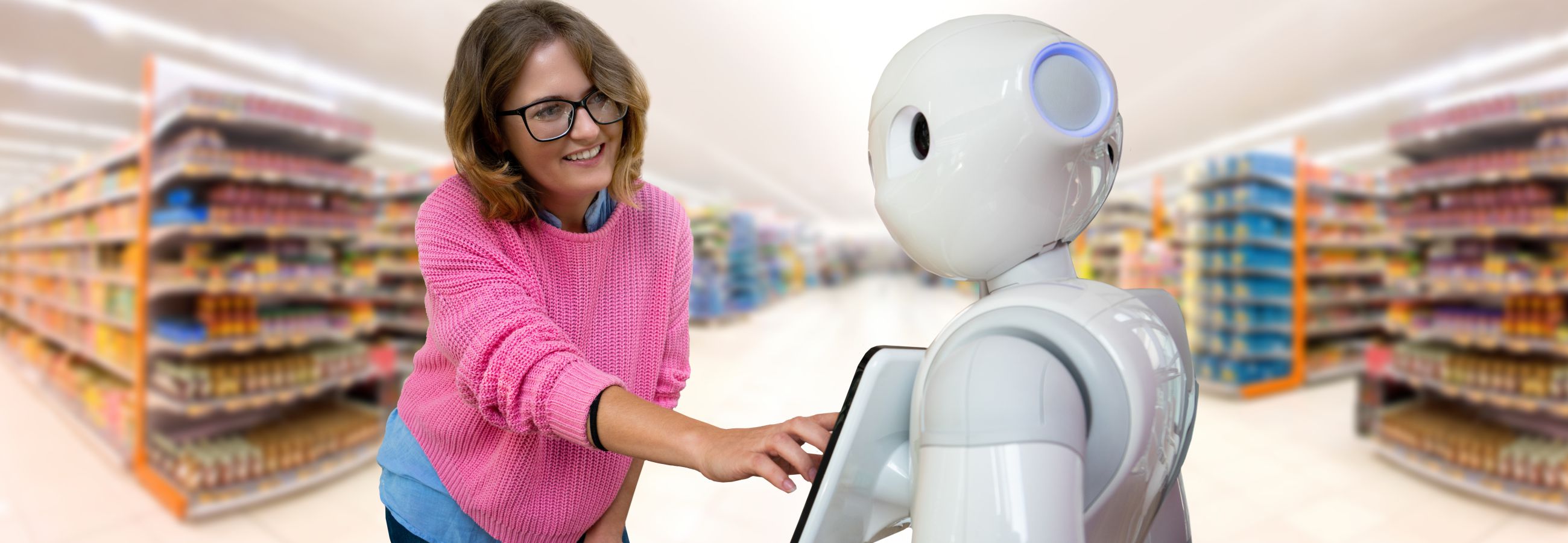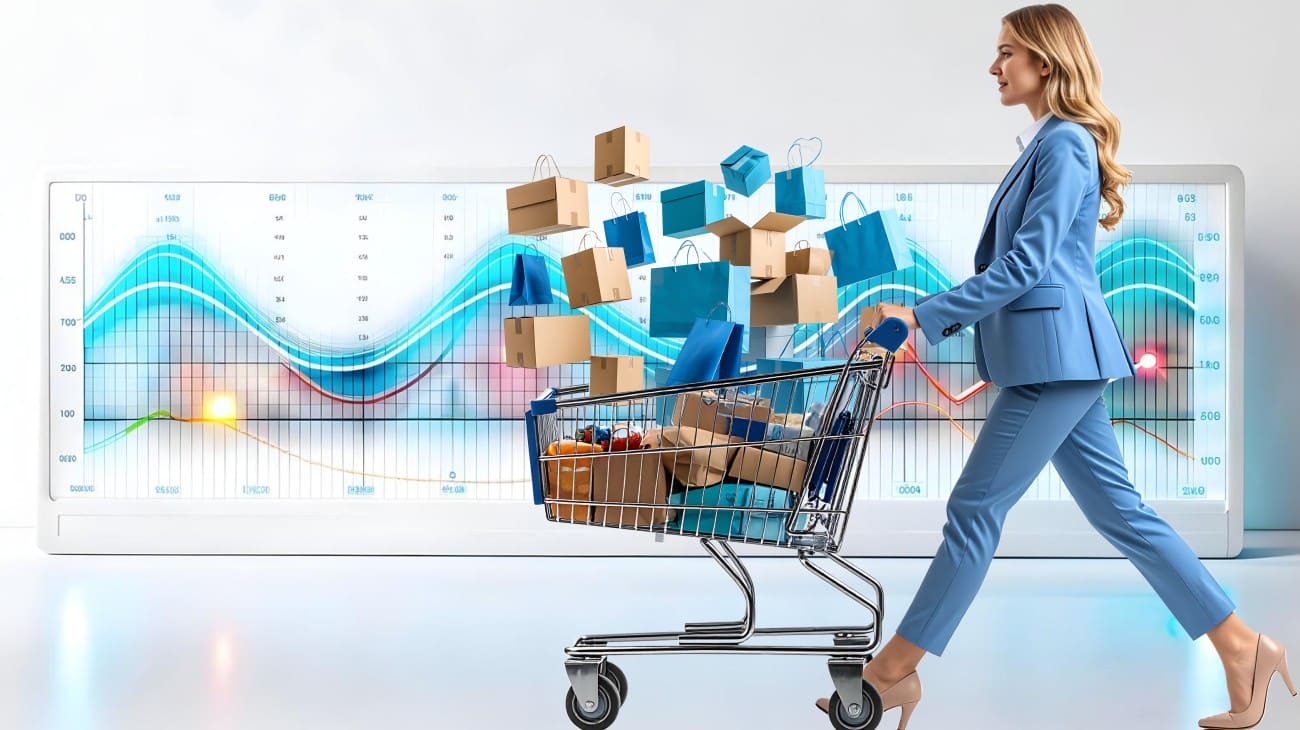Seller, buyer and product are the three main components of trade. No matter how this form of human activity has changed over the past millennia, these components remain unchanged. While changes take place all the time, it is very difficult to observe them in the short term. However, it is possible. Mike Savitsky, Tech Lead of Goods Checker IT solution for retail at IBA Group, will talk about the changes that have taken place in recent years and how retail trends affect retail in 2023. He identifies five major trends that affect the FMCG market.
Table of Сontents
Roles of Online and Offline Channels for Sellers and Buyers

Offline business is valued for impressions and unique buyer experience; the purchases are more emotionally involved. This is a smarter and faster purchase.
Its value for sellers:
- Worldwide access. Online platforms allow merchants to reach a global audience without geographical restrictions. This allows merchants to expand their market and attract new customers from different countries and regions.
- Better visibility. Online stores and marketplaces provide merchants with an opportunity to enhance their visibility and reach more potential buyers. They can use targeted advertising, search engine optimization, and social media to drive attention to their products.
- Lower costs. Online shopping can be more cost effective compared to conventional offline stores. Merchants can save on store rental costs, improve inventory, and streamline logistics and delivery processes.
Value of online sales channels for buyers:
- Convenience and accessibility. Online shopping provides customers with the ability to shop anytime, anywhere. They can search and compare products, read customer reviews, shop and receive products right at home.
- Wide range of choice. In online stores, customers have access to an extensive range of goods and services. They can find products from different vendors and compare their prices and features before making a choice.
- Personalization and recommendations. Online platforms often use algorithms and shopping behavior data to provide customized recommendations and promotions. Buyers may receive offers that match their interests and preferences.
There is also a variety of offline channels of communication and interaction that remain in high demand and are important, despite the growth in popularity of online retailing. Here are the main roles of offline channels for sellers:
- Unique shopping experience for customers. In an offline store, the seller can create a unique visual and atmospheric experience to attract customers. In addition, it provides an opportunity to communicate directly with customers, which helps to establish trust and enhance loyalty.
- Advertising. An offline store is a platform for presenting your products or services to a wide audience. The seller has the opportunity to attract attention and create interest in products, establish direct relationships with potential customers and partners.
- Building loyalty. The seller has the opportunity to yield new insights into the choices and requirements of customers through direct communication. It can also provide personalized recommendations and solutions for specific choices. This contributes to the establishment of long-term business relationships.
Role for buyers:
- Conscious choice. The ability to directly examine and evaluate goods before purchase, which prevents disappointment upon receipt of the goods. Opportunity to take advice and recommendations from sellers, which helps to make a more informed choice.
- Confidence in the purchase. Opportunity to have a look at various products and services in one place and compare them. Opportunity to view demonstrations and product testing before purchase. A chance to find unique, rare or specialty items that may not be available in regular stores.
- Assistance. Opportunity to ask questions and get immediate answers from sellers. Personalized approach to the choice of products or services, taking into account individual wants. Feel confident in your decisions thanks to additional expert support.
These offline channels remain important for merchants and buyers, as they provide a variety of opportunities for interaction and create unique shopping experiences that are not always available in the online environment.
Online and offline retail will be even more efficient if they complement each other, as customers often go to the store to look for the right product, and then purchase it online. Market actors are well aware of this, so this type of integration is the future of retail business, where offline stores play the role of showcases with goods, and online stores play the role of actual platforms for selling and buying.
Top Offline Business Trends

Rapid development of e-commerce is not exclusive of the importance of offline retail which continues to undergo significant changes under the influence of new trends. There are currently new trends in business marketing, such as the growing demand from consumers for a unique and satisfying offline shopping experience. New technologies, changes in consumer behavior and the desire to improve customer communications determine the emergence of innovative approaches to offline retail space planning. In this context, manufacturers and merchants are facing challenges and opportunities that are shaping new trends in offline shopping and require adapting to changing consumer expectations and needs.

Focus on sustainability and conservation
Today, more and more manufacturers and retailers are focusing on sustainability and nature conservation in offline purchases, responding to the growing demand from conscious consumers. This trend is becoming important not only for the ecological well-being of the planet, but also for the creation of sustainable and responsible business models.
Manufacturers and retailers are starting to take action to reduce the negative impact on the environment. They strive to use environmentally friendly materials, improve the energy efficiency of their production processes and reduce waste. In addition, they implement disposal and recycling programs to minimize their environmental footprint.
In offline stores, retailers are taking steps to reduce the use of disposable packaging and plastic materials. They offer alternatives such as biodegradable packaging or reusable bags and containers. In addition, many stores introduce the feature of waste sorting and offer collection facilities for recycling.
Nature conservation is also becoming an important consideration in the selection of product suppliers. Many companies are actively seeking ways to reduce their environmental footprint by partnering with suppliers who are also committed to sustainability. This may include the use of clean production methods, sustainable agriculture and efficient resource management systems.
The focus on sustainability and conservation in offline shopping not only contributes to the preservation of the environment, but also meets the growing needs of environmentally conscious shoppers. Such measures help manufacturers and sellers not only attract new customers, but also create long-term relationships based on mutual trust.
The latest Pulse survey shows that 58% of millennials (27-36) say they are greener than they used to be, but Generation Z remained indifferent to this issue.

Local producers preferred
Another new trend is the search for alternatives for products that have become unavailable due to a global supply disruption, weakening of loyalty to familiar brands and willingness to replace them with others. In particular, we are talking about the choice of products from local manufacturers to reduce the risk of supply disruptions.
According to research by Nielsen, about 73% of consumers around the world prefer to buy goods from local manufacturers. This number continues to grow every year. In the US, according to a report by the Small Business Administration, small businesses make up about 99.9% of all businesses in the country. Many consumers strongly support local entrepreneurs, understanding the importance of their role in the economy and social development.
In Europe, according to a study by Eurobarometer, about 75% of consumers consider it important to buy products from local producers. They note that this contributes to the development of local communities, the preservation of cultural heritage and the reduction of environmental impact.
In Japan, the number of small manufacturers in the country has increased by 30% since 2011, according to the Japan Manufacturers Association. This is due to the growing demand of Japanese consumers for local products which are associated with high quality and tradition.
These statistics prove out that consumers are increasingly appreciating the benefits of buying from local producers. This trend creates opportunities to develop local economies, strengthen communities and preserve cultural and environmental values.

Demand for contactless solutions
Modern shopper is showing an increasing demand for contactless shopping solutions. This is due to the development of technology, changing consumer behavior and the pursuit of safety and convenience. Here are some of the key factors behind this demand:
Safety. In the face of the COVID-19 pandemic, safety has become a top priority for shoppers. Contactless solutions, such as contactless payments, self-service and online ordering with delivery, allow avoiding physical contact with other people and improve hygiene and safety.
Convenience and speed. Contactless solutions provide customers with convenience and speed in the shopping process. They can pay for goods quickly and conveniently using mobile payment systems or proximity cards. Also, online shopping and delivery allows them to avoid visiting the store and save time.
Advancements in technology. The development of technologies such as NFC (Near Field Communication), mobile applications and payment systems has made contactless solutions more accessible to a wide audience. Consumers are increasingly using smartphones and are willing to use them for contactless payments and other transactions.
Environmental awareness. Contactless solutions are also in line with the growing environmental awareness of customers. They avoid the use of paper or plastic coupons and checks, and cut down on the use of paper and energy in the shopping process.
Because of these factors, the modern shopper is increasingly expecting contactless solutions from merchants. Companies must meet this need by providing secure and convenient shopping through various channels, including online stores and mobile payment systems.
According to Forbes, up to 77% of consumers expect an increase in the use of contactless solutions such as voice assistants or facial recognition systems to avoid contact. Contactless payment methods and services will be a trend that will continue for the foreseeable future.

Conscious consumption
The trend towards conscious consumption is a significant shift in the consumer behavior of modern buyers. Conscious consumers strive to make informed and responsible choices for products and services that are consistent with their values, health, environment and society as a whole.
Conscious consumers pay great attention to environmental issues. They prefer products that are produced with minimal environmental impact, use sustainable materials, energy efficient processes and packaging, and take steps to reduce waste.
Conscious consumers also pay attention to the ethical aspects of the production of goods and services. They tend to avoid products that involve human rights violations, labor exploitation, or animal cruelty. They favor companies that adhere to high standards of social responsibility.
Today, people value product quality and durability more. They prefer to invest in products that will last a long time without requiring regular replacement or repair. Thus, they cut down consumption and environmental impact.
The trend towards conscious consumption reflects the growing awareness and consciousness of consumers about the consequences of their purchases.

“DIY” instead of a new purchase
The trend towards “Do it yourself” instead of a new purchase is a noticeable shift in the consumer behavior of modern people. Instead of acquiring new goods, they increasingly prefer to create, restore or remake existing items on their own.
This approach provides consumers with the opportunity to develop their creativity and express themselves. People find satisfaction in creating unique and personalized items that reflect their own style and feeling. It also saves resources and money. Instead of buying a new product, people can use the materials or secondary resources they have to create or restore items. It also helps to reduce waste and environmental impact.
Furthermore, people want to develop new skills and become more self-sufficient. They can learn various repair, handicraft or creative skills that bring them satisfaction and increase their confidence in their own abilities. Many appreciate originality and uniqueness in the world of mass-produced and similar products. They strive to stand out and create something special that cannot be found in stores.
This trend stimulates creative thinking, promotes environmental awareness and strengthens the connection between the consumer and the items they create. It allows people to enjoy the process of creating and give special meaning to their things.
The entire DIY market is predicted to grow up to $1.1 trillion by 2025.
Challenges that new trends pose for manufacturers and sellers

The development of offline business ideas poses various challenges for manufacturers and merchants.
Consumer preferences. Consumers are increasingly prioritizing convenience and personalization in their buyer experience. Manufacturers and merchants must be ready to offer new and innovative ways to attract and retain customers, such as interactive storefronts, loyalty campaigns and personalized service.
Technological innovation. The introduction of new technologies such as robots, drones, face recognition, smart cash registers and analytics systems provides manufacturers and merchants with new opportunities to increase operational efficiency, reduce costs and improve the customer experience.
Competition with online retail. With the development of e-commerce and the popularity of online platforms, offline retail is facing increased competition. Manufacturers and merchants must develop strategies to coexist with online retail and provide the unique benefits of offline shopping, such as immediate availability of goods, the ability to physically check and try on.
Sustainability and environmental friendliness. As consumer awareness of sustainability and environmental responsibility grows, manufacturers and retailers should strive to incorporate sustainable practices into their business models and products. This may include using sustainable materials, improving energy efficiency and reducing waste.
Omnichannel experience. Consumers expect to combine online and offline shopping into a single experience. Manufacturers and sellers must create coherent strategies across different distribution channels to provide a consistent and seamless experience for buyers.
In today’s accelerating world, manufacturers and retailers need to actively adapt to ever-changing challenges and trends. Keeping track of consumer preferences, technological innovation and social change becomes an integral part of a successful business strategy. New offline retail business trends and challenges may result in significant changes in the way we manufacture, market and interact with customers. Those companies that are flexible, creative and willing to continually improve will be at the forefront of the industry and can effectively meet the needs of today’s consumers. The future of successful manufacturers and sellers will depend on their ability to pick up new trends and transform challenges into opportunities for growth and development.




